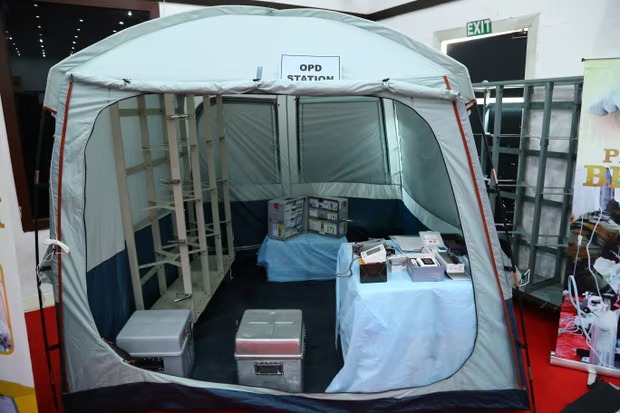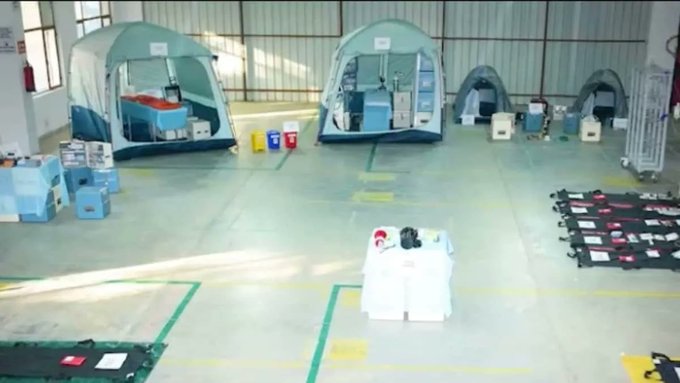This mobile/portable hospital had to be small and light, which meant equipment had to be reduced in size and constantly weighed to check a helicopter could take the load.
Nirendra Dev / New Delhi
India has designed and built a “flatpack” field hospital that can be flown to a disaster area by helicopter and assembled faster than an Ikea bookcase, reports ‘The Guardian’, London. The portable unit, comprising mini cubes of medical equipment, enables surgeons to be operating within an hour, designers claim.

Notably, sources said the central government has given a set of the cubes to two neigbouring countries Myanmar and Sri Lanka as well.
The ‘Aarogya Maitri Aid Cube’, may be called India’s first portable hospital, has 72 small cubes containing equipment that can facilitate life-saving surgery on remote and tough terrains.
Well, it can be airlifted to a disaster area and assembled in an hour.
The hospital is part of an ambitious healthcare project initiated by the Indian prime minister, Narendra Modi, to support low-income countries affected by natural disasters.
“Project BHISHM, the world’s first completely indigenous portable hospital.
A groundbreaking initiative aiding rescue missions worldwide. Building on the spirit of Vaccine Maitri, India introduces Aarogya Maitri, extending support globally,” tweeted Union Ministry of Health ad Family Welfare.
The hospital is contained in 72 small waterproof cubes, each weighing under 15kg and measuring 38cm x 38cm x 38cm (15 x 15 x 15in). They are packed with tents and specially designed medical equipment.
The cubes can be transported to war zones or the sites of natural disaster such as floods and earthquakes in remote areas, and are tough enough to withstand being airdropped from a plane or helicopter.
It takes five trained people one hour to assemble the cubes into a fully functional hospital for doctors to treat injuries and perform life-saving surgery. Each is equipped to treat up to 200 patients. India’s health ministry said: “It can provide critical medical care, making it a lifeline in remote and tough terrains where immediate medical attention is needed.” The Aarogya Maitri Aid Cube hospital, launched recently, has small intensive-care units, an operating theatre and a range of equipment including portable X-ray and ultrasound machines and ventilators. It is powered by a generator charged by solar panels, and comes with water and a cooking station.

Air Vice Marshal Tanmay Roy said that the mobile hospital is part of India’s message of health for all and assisting other nations during their times of crises.
The World’s first portable hospital, ‘Aarogya Maitri Aid Cube’ was unveiled on Saturday (2nd December 2023) in Gurugram. Designed indigenously under the Project ‘BHISHM’, the modular trauma management and aid system is made up of 72 detachable mini-cubes, each being a specialized station for emergency response and humanitarian efforts.
It can handle bullet injuries, burns, head, spinal and chest injuries, minor surgeries, fractures and major bleeding. It can treat as many as 200 patients. These cubes are light and portable, and can be rapidly deployed anywhere, from airdrops to ground transportation.
The structure will also contain a tablet-based application which can operate all 72 cubes.
About Aarogya Maitri Aid Cube:
It is the world’s first portable hospital. Designed indigenously under Project BHISHM (Bharat Health Initiative for Sahyog Hita and Maitri), the modular trauma management and aid system is made up of 72 detachable mini-cubes, each being a specialized station for emergency response and humanitarian efforts.
It contains medical equipment and supplies such as a mini-ICU, an operation theatre, cooking station, food, water, a power generator, blood test equipment, an X-ray machine, and more.
The cubes are capable of handling patients with severe injuries up to 25 major burns, long limb fractures, chest injuries, spinal injuries and approximately 10 head injuries.
It can treat as many as 200 patients.
These cubes are light and portable, and can be rapidly deployed anywhere, from airdrops to ground transportation.
It consists of 72 cubes that can be combined to form a specialized cage capable of accommodating 36 mini-cubes. The mini-cubes are packed with everything essential for the survival of 100 individuals for duration of 48 hours.
There are two master cubes designed to be interconnected, allowing them to accommodate a maximum of 200 survivors. The total weight of every master cube with 36 cubes is less than 750 kilos. It relies on the Rubik’s Cube concept and each of the cubes is designed to weigh less then 20 kilos to make it easy to carry up manually.
The cubes’ versatility and how they can be configured is lauded by HLL Lifecare, the state-owned company behind their design. Dr Ankita Sharma, a consultant with HLL Lifecare, said: “If the immediate need at the site is for life-saving surgery, then the operating theatre can be assembled first. This takes just 10 minutes. The doctors can start surgery while the remaining cubes are assembled.”
While the contents of 60 cubes are mandatory, the contents of the remaining 12 can be modified to suit different situations. “If it’s an earthquake where you get lots of fractures, then you pack in more cubes containing equipment for bone injuries and remove some of the bleeding injury kits needed for soldiers with bullet or bomb injuries,” she has been quoted as saying in ‘The Guardian’.
Sharma said it took a year of working with doctors, army medics, engineers and designers to come up with the blueprint.
